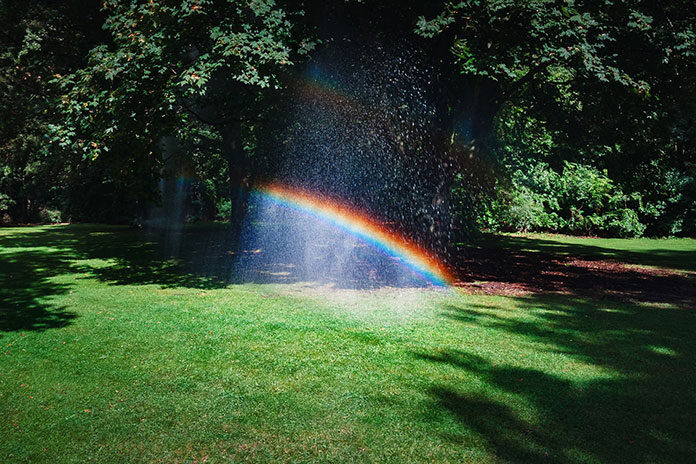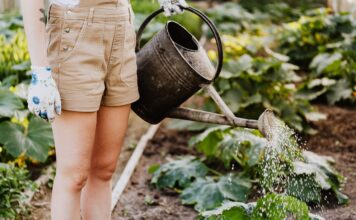In this comprehensive article, readers will learn the importance of lawn care and its environmental, aesthetic, and property value benefits. The article will guide readers on how to assess their lawn needs by considering grass type, soil condition, sunlight exposure, and drainage. Additionally, it covers proper mowing and maintenance techniques, including the right watering frequency and techniques, as well as the use of smart irrigation systems.
Furthermore, the article delves into fertilizing and soil care, offering advice on choosing the right fertilizer, fertilizing frequency, soil testing, and organic lawn care options. It also addresses weed, pest, and disease control by discussing types of weeds, common lawn pests, and integrated pest management. To maintain a healthy lawn, readers will also learn the importance of aeration and dethatching, along with overseeding and lawn repair techniques. Finally, the article provides seasonal lawn care tips for spring, summer, fall, and winter.
Importance of Lawn Care
A well-maintained lawn not only enhances the beauty of your property but also benefits the environment in many ways. Lawn care may seem like a simple task, but it requires consistent efforts like mowing, fertilizing, watering, and weed control. Undoubtedly, it contributes to the overall wellbeing of the ecosystem that surrounds the property. This article aims to shed light on the significance of lawn care and its various benefits.
Environmental Benefits
A healthy and well-maintained lawn has several environmental advantages. Here are a few.
- Improved Air Quality: Grass absorbs carbon dioxide and converts it into oxygen through the process of photosynthesis. A 2,500 square-foot lawn can generate enough oxygen for a family of four, resulting in cleaner air for everyone. Moreover, grass leaves also absorb airborne dust and other pollutants, significantly reducing dust and smog.
- Soil Erosion Control: A dense lawn with a healthy root system makes the soil more stable, preventing erosion caused by wind and water runoff. The roots act as a barrier to water, slowing down runoff and allowing it to be absorbed into the soil. This reduces the chances of soil being washed away during heavy rains, protecting the surrounding landscapes and waterways from sedimentation damage.
- Water Filtration: As rainwater seeps through the grass and soil, it gets filtered and cleansed of potential pollutants. This natural filtration system purifies the water, which eventually replenishes underground water reserves. Moreover, a well-kept lawn acts as a sponge, absorbing excess water and reducing the risks of flooding in the surrounding areas.
- Climate Regulation: Lawns play a significant role in mitigating the urban heat island effect. Green spaces like lawns work to absorb sunlight and cool the surrounding air through a process called transpiration. This effect can contribute to lower energy consumption for cooling purposes and can create a more comfortable living environment.
Aesthetic Appeal
A well-maintained lawn enhances the overall appearance of your property. Regular lawn care, including mowing, fertilizing, and watering, will make the grass healthier and greener. Lush grass also creates a vibrant and visually appealing backdrop for other elements in your landscape, such as flower beds or architectural features. A well-groomed lawn can turn your outdoor space into a welcoming oasis and increase the overall enjoyment of spending time in the yard.
Furthermore, proper lawn care contributes to the overall look and feel of a neighborhood. A well-kept lawn reflects positively on homeowners’ efforts in maintaining their properties, contributing to the sense of pride and community within the neighborhood.
Property Value Enhancement
A well-maintained and attractive lawn adds value to your property. Homebuyers tend to perceive properties with neat and tidy lawns as well-cared-for and well-maintained. A well-kept lawn signifies that the current homeowners have taken the time and effort to maintain the property diligently. This perception can have a direct and positive impact on the property’s market value.
In addition to improving the value of your property, a well-maintained lawn can also have a broader impact on the neighborhood’s property values. A neighborhood with consistently well-kept lawns and landscapes tends to attract homebuyers more than one with unkempt yards. This increased desirability can lead to higher property values for all the homes in the area.
In summary, the importance of lawn care cannot be overstated. It offers numerous environmental, aesthetic, and property value enhancements that make it a worthwhile investment for homeowners. Regular and consistent lawn care will not only improve the overall appearance of your property but also contribute to the health and wellbeing of the environment and community.
Assessing Lawn Needs
Before you start any lawn renovation or maintenance, it’s crucial to first assess your lawn’s overall health and specific needs. This will help you determine the best course of action to take and ensure that your lawn remains healthy and vibrant. Some essential factors to consider when evaluating your lawn’s needs include grass type, soil condition, sunlight exposure, and drainage and irrigation systems.
Grass Type
Identifying the type of grass growing in your lawn is vital since different grass species have different needs and tolerances. There are generally two main types of grasses: warm-season grasses and cool-season grasses. Warm-season grasses, such as Bermudagrass, Zoysia, and St. Augustine, grow best in warmer climates and have a higher heat and drought tolerance. On the other hand, cool-season grasses, like Kentucky Bluegrass, Fescue, and Ryegrass, thrive in colder climates and can tolerate more shade.
To determine which grass species you have, observe its growth patterns, leaf shape, texture, and color. You can also take a sample to your local garden center or consult the representatives in the seed department. Understanding your grass type will allow you to implement appropriate maintenance practices, such as proper mowing height, irrigation, and fertilization.
Soil Condition
The soil’s health greatly contributes to your lawn’s overall condition, as it is responsible for providing your grass with essential nutrients and proper drainage. Therefore, it’s crucial to regularly test your soil’s pH level and nutrient content. Lawns generally prefer slightly acidic to neutral soil with a pH range of 6.0 to 7.0. Most grass species struggle to absorb nutrients if the soil pH is either too high (alkaline) or too low (acidic), which can lead to weak growth and susceptibility to diseases and pests.
In addition to pH, your soil test should also indicate the levels of key nutrients, such as nitrogen, phosphorus, and potassium. Based on the results of your soil test, you can adjust your fertilization practices and incorporate organic matter like compost or peat moss to improve soil structure and nutrient content.
Sunlight Exposure
Grass requires adequate sunlight to ensure healthy growth and photosynthesis. Different types of grasses have varying sunlight requirements, but, as a general rule, most types need at least 6 hours of direct sunlight daily. Assess your lawn’s sunlight exposure by observing its shaded areas throughout the day to determine if your grass is getting adequate light.
If you discover that your grass is struggling due to poor sunlight exposure, you may need to consider pruning back overgrown trees or shrubs that are blocking the light or replacing the grass with a shade-tolerant species that can thrive in low-light conditions.
Drainage and Irrigation
Proper water drainage and irrigation are essential components of a healthy lawn. Excessive water can lead to shallow root systems and increase the risk of diseases and pests, while inadequate water supply can lead to drought stress and nutrient deficiencies.
When assessing your lawn’s drainage, examine the area for signs of standing water or soggy patches after rainfall or irrigation. If drainage is a problem, you may need to install a drainage system or consider amending your soil to improve its ability to retain and drain excess water.
Regarding irrigation, most lawns require about 1 inch of water per week, either through rainfall or supplemental watering. Monitor your lawn’s water needs by using a rain gauge, soil moisture probe, or simply sticking your finger into the soil. If you find that your lawn isn’t receiving enough water, you may need to adjust your watering practices or consider implementing water-saving techniques such as drought-tolerant grass types or installing an efficient irrigation system.
Mowing and Maintenance
A well-maintained lawn not only improves the aesthetic appeal of your home but also provides various environmental benefits. Proper mowing and maintenance are crucial to ensuring a healthy and beautiful lawn. This article will discuss the proper mowing techniques, mowing frequency and height, and the importance of maintaining your lawn mower.
Proper Mowing Techniques
Mowing your lawn may seem like a simple task, but improper mowing techniques can lead to an unhealthy and unsightly lawn. Here are some tips to ensure that you are using the correct techniques when mowing your lawn:
- Make sure your lawn mower blades are sharp: Dull blades can tear the grass, rather than cut it, which can make your lawn more susceptible to diseases and pests. It is recommended to sharpen your mower blades at least once or twice a year.
- Mow when the grass is dry: Mowing wet grass can cause clumping and uneven cutting, resulting in a poor appearance and potentially damaging your lawn. Wait for the grass to dry before mowing, and avoid mowing in the early morning or shortly after a rain.
- Change your mowing pattern: Mowing in the same pattern every time can cause your grass to grow in a specific direction, which can lead to uneven growth and compaction of the soil. Be sure to change your mowing pattern regularly to encourage healthy and upright growth.
- Don’t mow too short: Scalping your grass by cutting it too short can make it more susceptible to weeds, disease, and drought. It is important to maintain the proper grass height, which will be discussed in the next section.
- Leave grass clippings on the lawn: Grass clippings act as a natural fertilizer for your lawn, returning essential nutrients back to the soil. Leaving grass clippings on the lawn can help improve the overall health and appearance of your grass.
Mowing Frequency and Height
The frequency at which you mow your lawn and the height you cut your grass plays a vital role in the overall health of your lawn. Mowing frequency should be based on the growth rate of your grass, which can be influenced by factors such as weather, soil conditions, and fertilizer usage.
- Mowing frequency: In general, it is best to mow your lawn every 7-10 days during the active growing season. However, this frequency may vary depending on the type of grass and weather conditions. It is important not to remove more than one-third of the grass height at any one time, as this can stress the grass and lead to various lawn problems.
- Mowing height: The ideal mowing height varies depending on the type of grass you have. Here are some general guidelines for common grass types:
- Cool-season grasses (e.g., Kentucky bluegrass, perennial ryegrass, fescues): 2.5 to 4 inches
- Warm-season grasses (e.g., Bermuda, zoysia, St. Augustine): 1 to 3 inches
- Adjusting the mowing height: During periods of drought or high temperatures, it is recommended to raise the mowing height to reduce water evaporation from the soil and increase the grass’s ability to withstand stress. Conversely, during periods of high rainfall or cooler temperatures, you can lower the mowing height to help prevent the growth of diseases and improve the overall appearance of your lawn.
Maintenance of Lawn Mower
To ensure optimal performance and maintain the health of your lawn, it is essential to regularly maintain your lawn mower. Some basic maintenance tasks include:
- Cleaning the mower: After each use, be sure to clean the mower’s deck and blades to remove grass clippings and debris. This can help prevent the spread of diseases and ensure even cutting.
- Check and replace the air filter: A clogged air filter can affect the performance of your lawn mower’s engine. Make sure to clean or replace your air filter according to your mower’s manufacturer recommendations.
- Change the oil: Regularly changing the oil in your lawn mower can prolong the life of the engine and improve performance. Consult your mower’s owner’s manual for the recommended oil change frequency and the correct type of oil to use.
- Inspect the spark plug: A worn or damaged spark plug can cause your lawn mower’s engine to run poorly or not start. It is a good practice to check the spark plug periodically and replace it when necessary.
- Check tires and wheels: Make sure your lawn mower’s tires are properly inflated and the wheels are in good condition. Uneven or damaged wheels can cause poor cutting and uneven lawn surfaces.
In conclusion, proper mowing and maintenance are essential to maintaining a healthy and beautiful lawn. By adopting the correct mowing techniques, adjusting mowing frequency and height according to your grass type and conditions, and regularly maintaining your lawn mower, you can ensure your lawn reaches its full potential.
Watering and Irrigation
Watering and irrigation are essential aspects of maintaining a healthy and well-established garden. Proper watering practices keep plants hydrated, promote growth, and help prevent diseases. This section covers the essential elements of watering and irrigation, including watering frequency, watering techniques, smart irrigation systems, and signs of overwatering or underwatering.
Watering Frequency
The frequency with which you should water your garden depends on several factors, including the types of plants, local climate, soil type, and the size of your garden.
- Types of plants: Different plants have different water requirements. For instance, succulents and drought-tolerant plants require less water than water-hungry plants such as tomatoes or lush, tropical plants.
- Local climate: The climate and weather can impact how often you need to water. In arid regions or during hot, dry seasons, you may need to water more frequently than in cool, wetter climates. Additionally, rainfall frequency and amount should be taken into account when deciding when to water.
- Soil type: The texture and composition of your soil can also affect water retention and drainage. For example, sandy soils tend to drain water quickly, requiring more frequent watering, while clay soils can hold water longer, requiring less frequent watering.
- Garden size: The size of your garden and the number of plants you have can also influence watering frequency. A larger garden may need more frequent watering or an irrigation system to ensure all plants receive sufficient water.
As a general rule, most plants prefer to have slightly moist soil but not be waterlogged. In most cases, a thorough weekly or bi-weekly watering should suffice. Make sure to water early in the morning or late in the evening to prevent water evaporation and ensure maximum absorption by the plants.
Watering Techniques
There are several watering techniques you can employ to ensure your garden thrives:
- Hand watering: Hand watering is the most basic watering technique, involving simply using a watering can or hose to water your plants. This method can be time-consuming and labor-intensive but allows for targeted and precise water application.
- Sprinklers: Sprinkler systems cover a larger area and can be set up to run automatically at set intervals, making them more efficient than hand watering. However, sprinklers can sometimes waste water by watering non-plant areas or by evaporating water in hot climates.
- Drip irrigation: Drip systems deliver water slowly and directly to the plant’s root zone, using a series of tubes and emitters. This method is water-efficient and ensures more consistent soil moisture, but it may also require more maintenance than other methods.
- Soaker hoses: Soaker hoses are porous hoses that allow water to seep slowly into the soil. They can be positioned close to plant bases to deliver water directly to roots, resulting in reduced evaporation and better water efficiency.
Smart Irrigation Systems
Smart irrigation systems are becoming increasingly popular, as they provide a more efficient and user-friendly approach to garden watering. These systems utilize technology such as soil moisture sensors, weather sensors, and WiFi connectivity to determine plants’ optimal watering schedule.
A smart irrigation system can be programmed to run on a specific schedule, which can be adjusted based on real-time data from the sensors. This level of control and automation can save water, prevent overwatering or underwatering, and reduce the time and effort required to maintain a healthy garden.
Signs of Overwatering or Underwatering
Recognizing the signs of overwatering or underwatering is essential for maintaining a healthy garden. Some common indicators are:
- Overwatering:
- Yellowing leaves or leaf drop: Excess water forces oxygen out of the soil and can cause plant roots to rot, leading to yellowing leaves or leaf drop.
- Mold or fungus: Excess moisture creates the ideal conditions for mold and fungus to thrive.
- Wilting even in wet soil: When roots suffocate due to overwatering, they can’t take up water or nutrients, causing the plant to wilt despite ample moisture in the soil.
- Underwatering:
- Dry, crispy leaves: When plants receive insufficient water, their leaves may become dry, brittle, and brown.
- Slow or stunted growth: Persistent underwatering can lead to slower-than-normal growth rates, a lack of new growth, or overall stunting in plant development.
- Wilting in dry soil: The lack of water can cause plants to wilt as they struggle to maintain proper internal water balance.
Monitoring your plants for these signs and adjusting your watering practices accordingly can help ensure a thriving, healthy garden.
Fertilizing and Soil Care
Proper fertilization and soil care are essential for maintaining a healthy, thriving lawn. A well-fertilized lawn not only looks lush and green but also has a strong root system that can resist weeds, diseases, and pests. Soil care, on the other hand, involves maintaining the right balance of nutrients, pH levels, and microorganisms to support healthy grass growth. This section covers the aspects of choosing the right fertilizer, fertilizing frequency, soil testing and amendment, and organic lawn care options.
Choosing the Right Fertilizer
Selecting the appropriate fertilizer is crucial for the health and growth of your lawn. A basic lab test can help determine the nutrient requirements of your soil. The results will guide you in selecting the right fertilizer ratio of nitrogen (N), phosphorus (P), and potassium (K), which is indicated on the product label as three numbers (e.g., 20-10-10).
Nitrogen is responsible for promoting grass growth and the rich green color. Phosphorus aids in root development, and potassium contributes to overall plant health and disease resistance. Different grass species and soil types may have different nutrient requirements; therefore, a soil test can enable you to choose a well-suited fertilizer.
Fertilizer types include granular, liquid, and slow-release. Granular fertilizers are easy to apply and provide a long-lasting effect, while liquid fertilizers offer a quicker but less prolonged impact. Slow-release fertilizers feed the lawn gradually, reducing the risk of burning the grass or leaching nutrients. Granular and slow-release fertilizers are generally recommended for healthy, long-lasting lawns.
Fertilizing Frequency
The proper fertilizing frequency depends on multiple factors, such as grass species, climate, soil type, and desired lawn quality. A general guideline is to fertilize your lawn 2 to 4 times per year. Here are some tips for scheduling your lawn fertilizations:
- Cool-season grasses: Apply fertilizer in early spring, late spring/early summer, and late summer/early fall.
- Warm-season grasses: Fertilize in late spring, summer, and early fall.
- If you are only fertilizing once or twice a year, the best times to do so are during the peak growing season for your grass type.
It is essential to follow the recommended application rates on the fertilizer label to avoid over-fertilizing, which can damage the lawn and the environment.
Soil Testing and Amendment
Soil testing is an essential step in determining the nutrient and pH levels of your lawn. Collect soil samples from different areas of your lawn, mix them together, and send them to a soil-testing lab. The results will include information on the soil’s pH and nutrient content, as well as recommendations on how to amend the soil.
It is essential to maintain a proper pH level in the soil, generally between 6.0 and 7.0 for most grasses. If the soil is too acidic, apply lime to raise the pH level; if it is too alkaline, sulfur can be used to lower the pH. Proper soil amendment can improve grass growth, nutrient uptake, and the ability of the soil to sustain a healthy root system.
Organic Lawn Care Options
Organic lawn care is an environmentally friendly alternative to traditional chemical-based lawn care practices. Organic fertilizers, such as compost, manure, and bone meal, provide nutrients to the soil without synthetic chemicals. These can improve soil health and are less likely to leach into groundwater or run off into nearby water sources.
Organic lawn care also emphasizes the use of natural pest control methods, such as introducing beneficial insects, using organic herbicides, and employing disease-resistant grass varieties. Mowing, watering, and aerating practices should also be adjusted to support a healthy lawn ecosystem.
In conclusion, proper fertilizing and soil care play a crucial role in establishing and maintaining a healthy and vibrant lawn. Regular soil testing is essential for choosing the right fertilizer types and nutrient ratios and maintaining optimal soil pH levels. Fertilizing frequency, organic lawn care options, and amendments should be tailored to your lawn’s specific needs and conditions. By implementing these practices, you can create a thriving, sustainable lawn and contribute to a healthier environment.
Weed, Pest, and Disease Control
Maintaining a healthy and beautiful lawn involves dealing with various challenges like weeds, pests, and diseases. In this article, we will discuss the types of weeds and their control, common lawn pests and their management, lawn diseases and prevention measures, and an integrated approach to manage these problems efficiently.
Types of Weeds and Their Control
Weeds are unwanted plants that compete with your lawn grass for nutrients, light, and space. They can be classified into two main categories: broadleaf and grassy weeds. Broadleaf weeds include plants like dandelions, clover, and chickweed, while grassy weeds usually comprise crabgrass and other unwanted grass species.
To control weeds in your lawn, you can adopt a combination of cultural, mechanical, and chemical methods. Cultural methods involve maintaining good lawn practices like proper mowing, fertilization, and water management. These practices promote the growth of healthy grass, which can outcompete weeds for resources.
Mechanical methods include hand-pulling or using tools like weed pullers to remove the weeds from your lawn. This approach is effective for small-scale weed issues. However, for stubborn or widespread weed problems, you can resort to chemical methods, which involve the use of herbicides.
Herbicides come in different forms, like pre-emergent and post-emergent formulations. Pre-emergent herbicides are applied before the weed seeds germinate, while post-emergent herbicides target actively growing weeds. When using herbicides, make sure to follow the product instructions carefully and select ones that specifically target the weed species in your lawn.
Common Lawn Pests and Management
Lawn pests are a common cause of poor lawn health, as they attack grass roots, destroy leaf tissues, and even transmit diseases. Some common lawn pests include grubs, chinch bugs, and sod webworms.
The first step in managing lawn pests is to identify the culprit by looking for signs of damage and observing the insects or their larvae. Next, adopt a combination of preventive measures and targeted treatments.
For preventive measures, maintain a healthy lawn through proper fertilization, mowing, and irrigation. You can also introduce beneficial insects like ladybugs and nematodes, which act as natural predators for certain lawn pests.
If you have an existing pest infestation, consider using insecticides formulated for the specific pest. Always follow the product guidelines for application rates and timings. Repeat treatments may be necessary for severe infestations.
Lawn Diseases and Prevention
Lawn diseases are mainly caused by fungi, which attack grass leaves and roots, resulting in unsightly patches, discoloration, or even death of grass. Common lawn diseases include brown patch, dollar spot, and red thread.
To prevent lawn diseases, follow these tips:
- Choose disease-resistant grass species and cultivars that are appropriate for your region and soil conditions.
- Maintain a healthy lawn with proper mowing, watering, and fertilization practices.
- Remove lawn debris, like leaves and grass clippings, to improve air circulation and prevent fungal growth.
- Regularly inspect your lawn for early signs of disease and treat them as soon as possible.
If lawn diseases persist, apply fungicides specific to the disease type. Follow the product guidelines carefully, and apply fungicides as a preventive measure during the disease-prone periods if necessary.
Integrated Pest Management
Integrated Pest Management (IPM) is a holistic approach to maintaining lawn health by combining the best practices of cultural, mechanical, and chemical methods. The goal of IPM is to manage weeds, pests, and diseases in an economically and environmentally sound manner.
To implement IPM successfully:
- Monitor your lawn regularly to identify weed, pest, and disease problems.
- Encourage healthy lawn growth through proper cultural practices, like mowing, fertilization, and water management.
- Use mechanical methods, such as hand-pulling weeds and introducing beneficial insects to manage pest populations.
- Apply chemical treatments like herbicides, insecticides, and fungicides selectively and according to product guidelines.
By following an IPM approach, you can effectively manage the weed, pest, and disease problems in your lawn while protecting the environment and conserving resources.
Aerating and Dethatching
Aerating and dethatching are two essential lawn care practices that contribute significantly to maintaining a healthy, lush, and vibrant lawn. These two processes help promote optimal root growth and enhance the overall health of your turf by improving soil conditions, reducing compaction, and allowing better penetration of water, nutrients, and oxygen.
Importance of Aeration and Dethatching
Aeration is the process of creating small holes or openings throughout the lawn’s soil surface, allowing air, water, and nutrients to reach the grassroots more effectively. As lawns age or suffer from heavy foot traffic or weight, soil can become compacted, making it difficult for water, air, and vital nutrients to penetrate the ground. Compacted soil also limits the grass’s ability to grow new roots and stifles the development of beneficial microorganisms necessary for a healthy ecosystem.
Dethatching, on the other hand, involves removing the excess layer of dead grass, roots, and other organic debris, called thatch, which accumulates between the soil surface and the grass blades. Thatch can choke the grass by preventing air, water, and nutrients from reaching the soil. When thatch buildup becomes too thick (more than half an inch), it becomes a breeding ground for pests and diseases, which can damage the lawn.
Both aeration and dethatching help promote a healthier lawn by allowing better circulation of air, nutrients, and water to the grassroots level, encouraging deeper root growth, reducing soil compaction, and improving lawn resilience.
Aerating Techniques and Tools
There are several tools and techniques available for aerating a lawn, varying from manual to power-driven equipment. The two main types of aeration are core aeration and spike aeration.
- Core aeration: This technique removes small cores or plugs of soil and grass using specialized equipment known as core aerators or lawn aerators. Core aeration is the most effective method to alleviate soil compaction and improve the lawn’s overall health. Both manual and power-driven aerators are available, with the latter being more efficient for larger lawns or heavily compacted soil.
- Spike aeration: Spike aeration involves poking holes in the soil using a spike aerator, which is a simple tool with metal spikes attached to a roller or wheel. This type of aeration is less effective than core aeration and is generally better suited for small lawns, golf courses, or as a supplemental technique in conjunction with core aeration.
Additionally, some homeowners utilize aeration shoes or sandals with metal spikes that can be worn while walking across the lawn to make small holes in the ground. These methods are less effective and may not provide consistent results.
Dethatching Techniques and Tools
Dethatching is the process of removing thatch buildup from your lawn to improve overall turf health. The most common techniques for dethatching are manual raking, vertical mowing (verticutting), and using a power rake or dethatcher.
- Manual raking: For small lawns or light thatch buildup, homeowners can use a manual dethatching rake with sturdy, sharp metal tines to break apart and remove the excess thatch layer. This method can be time-consuming and labor-intensive, but it is an affordable option for maintaining small lawns.
- Vertical mowing (verticutting): Verticutting uses a specialized mower with vertical blades that cut into the grass and thatch layer, slicing through the excess thatch and removing it from the lawn. This method is more efficient than manual raking and is a suitable option for larger lawns or heavier thatch layers.
- Power rake or dethatcher: A power rake or dethatcher uses rotating metal tines or spring-loaded teeth to lift and remove the thatch layer from the lawn. This equipment is more efficient than a manual rake or verticutter and is an ideal option for large lawns with significant thatch buildup.
Maintaining a healthy lawn requires a combination of regular care practices, such as watering, fertilizing, and mowing, along with periodic aeration and dethatching. By integrating these essential lawn care tasks, you can enjoy a robust, green, and attractive lawn throughout the growing season.
Overseeding and Lawn Repair
Overseeding is an essential lawn care process for improving the overall health, appearance, and quality of your turfgrass. Proper lawn care with overseeding and lawn repair helps create a dense, lush, and weed-free lawn. This article will discuss the benefits of overseeding, the best techniques to use, and the tips in handling lawn repair and patching.
Benefits of Overseeding
- Enhanced Lawn Density: Overseeding is the process of spreading grass seed over an existing lawn. Overseeding can be done to fill in bare spots, improve the appearance of the lawn, or to introduce new grass species that can better resist diseases, pests, and stress conditions, such as drought or high traffic.
- Improved Lawn Health: Overseeding can help strengthen weak lawns by introducing a variety of grass species that offer diverse characteristics, such as disease or drought resistance. By incorporating more robust grass varieties, the existing turf can better withstand stress factors that would otherwise result in lawn damage or deterioration.
- Weed Suppression: A dense and healthy lawn can effectively inhibit weed growth. Overseeding an existing lawn with grass varieties that complement the already established grasses can help create a more aggressive turf to choke out weed threats.
- Disease and Pest Resistance: Overseeding with improved grass species that are naturally resistant to specific diseases and pests can help reduce the chance of these issues developing. For example, introducing a more disease-resistant grass variety in your lawn can decrease the likelihood of fungus or harmful insect infestations.
- Enhanced Aesthetics: A thick, healthy, and vibrant lawn is the goal of most homeowners. Overseeding can improve the overall appearance of the lawn by filling in thin/bare spots and incorporating vibrant and hardy new grass varieties.
Overseeding Techniques
- Soil Preparation: Loosen the top 1/4-inch of soil in the area where you’ll be overseeding. This step will ensure better seed-to-soil contact and encourage germination. Remove any dead grass or debris and rake the area smooth.
- Select High-Quality Grass Seed: Choose high-quality grass seed that matches the characteristics of your existing grass, or select varieties that will enhance the overall performance of your lawn. It is essential to choose the correct grass species based on your region and the specific conditions of your lawn.
- Apply the Seed: Use a broadcast or drop spreader to evenly distribute the seed over the existing lawn. Be sure to follow the recommended seeding rate for your particular grass variety. Over-applying can lead to overcrowding and competition among the grasses, resulting in a less healthy lawn.
- Fertilize: Apply a slow-release starter fertilizer to provide the necessary nutrients for the new seedlings without overwhelming them.
- Watering: Keep the overseeded area consistently moist until the new seedlings reach a height of 2-3 inches. This may require light watering at least once or twice daily, depending on weather conditions.
- Mowing: Once your new grass reaches a height of 3-4 inches, mow at the recommended height for your specific grass species.
Lawn Repair and Patching
If your lawn exhibits thin or bare spots, you may need to repair portions of the turf. Some of the steps for lawn repair are:
- Identify the Problem: Determine the cause of the thinning or bare area. Common causes include pests, diseases, poor turf varieties, or soil compaction. Address the issue to prevent future damage.
- Prepare the Area: Remove dead grass or debris, and loosen the top 1/4-inch of soil in the damaged area.
- Select Appropriate Grass Seed: As mentioned in the overseeding section, choose a high-quality grass seed that will blend well with your existing turfgrass.
- Apply the Seed: Evenly distribute the chosen grass seed over the prepared area.
- Fertilize: Apply a slow-release starter fertilizer over the seeded area to promote healthy growth.
- Watering and Care: Keep the repaired area consistently moist until the new seedlings reach a height of 2-3 inches, and continue watering as needed for proper establishment.
By implementing these overseeding and lawn repair techniques, you can transform a tired or damaged lawn into a healthy, lush, and thriving outdoor space for you and your family to enjoy.
Seasonal Lawn Care
Lawn care is an essential part of maintaining a healthy and beautiful yard. Different seasons require different approaches to ensure optimal lawn health. In this article, we will discuss the necessary steps for seasonal lawn care, including spring, summer, fall, and winter.
Spring Lawn Care
Spring is a crucial time for lawn care, as it sets the stage for healthy growth throughout the year. Below are some essential steps for spring lawn care:
- Raking: Begin the season by raking your lawn to remove any dead grass, leaves, and debris accumulated during winter. This clears the way for new grass growth and helps prevent thatch buildup.
- Aeration: Spring aeration loosens compacted soil, allowing water, air, and nutrients to reach the grass roots. Rent a lawn aerator or hire a professional to do the job, ensuring the lawn is moist for effective aeration.
- Seeding: If you notice any bare spots in your lawn, it’s time to seed. Choose a grass seed blend that suits your climate and soil type, and spread the seeds evenly using a drop seeder. Water the newly seeded areas regularly to keep the soil moist and promote germination.
- Fertilizing: Applying a slow-release fertilizer in spring gives your lawn the nutrients it needs for healthy growth. Choose a fertilizer that is high in nitrogen and potassium, and follow the package instructions for application rates.
- Weed Control: Apply a pre-emergent herbicide to prevent weeds from taking root. For best results, time your application after the lawn’s first mowing, but before any crabgrass or other weeds have emerged.
- Watering: Begin by watering your lawn deeply and infrequently. This encourages deeper root growth, which is essential for a thriving, drought-resistant lawn. Aim for about 1 inch of water per week, either from rainfall or irrigation.
- Mowing: Begin mowing your lawn when the grass reaches about 3 inches in height. Aim to cut no more than one-third of the grass blade at a time. For optimal turf health, vary your mowing patterns to prevent soil compaction and rutting.
Summer Lawn Care
Summer poses unique challenges for lawn care, as heat, drought, and pests can lead to unhealthy and unattractive lawns. Here’s what you need to do during summer:
- Watering: Proper watering is more critical than ever during the hot summer months. Be sure to water early in the morning or late afternoon to minimize evaporation. Maintain the 1-inch weekly watering guideline, but remember that sandy soils may require additional watering.
- Mowing: Raise your mower’s cutting height slightly to help the grass retain moisture and stay cooler. Be sure to keep your mower’s blades sharp, as dull blades can damage the grass, causing it to lose moisture more quickly.
- Fertilizing: Skip fertilizing during the hottest months, as it can lead to excessive growth and increased vulnerability to heat and drought stress.
- Weed Control: Continue with post-emergent herbicides for any persistent weeds. If possible, hand-pulling or spot-spraying weeds is also effective during this time.
- Pest Control: Keep an eye out for pests and treat any infestations promptly. Grubs and other lawn insects can cause extensive damage in a short amount of time, so preventative insecticides are sometimes necessary.
Fall Lawn Care
Fall is the perfect time to nourish and prepare your lawn for the upcoming winter months:
- Raking: Rake fallen leaves to prevent them from smothering the grass and blocking sunlight. If you’re able, mulch the leaves and spread them onto the lawn as a natural source of nourishment.
- Aeration: If you didn’t aerate in the spring, fall is another excellent opportunity to do so. This helps address soil compaction and allows water, air, and nutrients to reach the grass roots.
- Overseeding: Fall is the best time to overseed any bare or thin areas in your lawn. The cooler temperatures help the grass seed germinate more effectively.
- Fertilizing: Apply a slow-release winterizer fertilizer that is high in phosphorus and potassium. This helps your lawn build stronger root systems and store more energy for winter survival and spring regrowth.
- Mowing: Begin reducing your mower’s cutting height one notch at a time until you reach around 2 to 2 ½ inches. This helps the grass resist matting and mold-related diseases during the winter.
Winter Lawn Care
During winter, the primary focus of lawn care should be on protecting and preserving the grass:
- Avoid walking on the lawn when there is frost, as this can cause the grass blades to break and damage.
- If it snows, avoid applying salt-based ice melt products on your driveway and sidewalk. These products can damage your lawn and nearby plants.
- Monitor your lawn for any signs of disease or pest activity, such as snow mold or voles. If you detect any issues, address them as soon as the weather permits.
By following these seasonal lawn care tips, you can maintain a healthy, beautiful lawn throughout the year. Committing to a season-specific approach will help ensure the best results and allow you to enjoy your outdoor space in every season.
1. What are the best practices for proper lawn care during the spring season?
In spring, proper lawn care includes mowing grass to an appropriate height, watering deeply and infrequently, applying pre-emergent herbicides for weed control, and fertilizing based on grass type and soil conditions. Spring is also an ideal time for dethatching, aerating, and seeding bare or thin spots in the lawn (Whiting & Wilson, 2009).
2. How often should a lawn be mowed during the growing season?
Mowing frequency should be dictated by the one-third rule: never remove more than one-third of the grass blade’s length at a time. Depending on the grass species and growth rate, lawns typically need mowing every 7-10 days during the active growing season to maintain optimal height and health (Tukey, 2007).
3. How much water does a healthy lawn typically need, and what is the best time to water it?
A healthy lawn generally requires about 1 to 1.5 inches of water per week, including rainfall. Watering should be done infrequently yet deeply to encourage deep root growth. The best time for watering the lawn is in the early morning, as it allows for better water absorption and minimizes evaporation (Kolka, 2016).
4. Which types of fertilizer are best for maintaining a healthy lawn, and how often should they be applied?
For optimal lawn health, use slow-release nitrogen fertilizers to offer a steady nutrient supply. Typically, applying fertilizer two to four times per year based on grass type and soil conditions is recommended, with the first application in spring after soil temperature reaches 55°F (12°C) and the final application in fall (Whiting & Wilson, 2009).
5. Can lawns benefit from using organic lawn care products and practices?
Yes, organic lawn care products and practices can promote a healthy, sustainable lawn. Compost, corn gluten meal, and organic fertilizers offer natural alternatives to synthetic products. Additionally, promoting healthy soil, encouraging natural predators, and using proper watering and mowing techniques reduce the need for chemical interventions (Tukey, 2007).
6. How can I prevent weeds from invading my lawn?
Preventing weeds in lawns involves implementing proper cultural practices that promote a strong, healthy turf. Adequate fertilization, proper mowing heights, and appropriate irrigation combined with pre-emergent herbicides effectively prevent weed invasion. Manual weeding and spot treatments are advisable when minimal weeds emerge (Walker, 2019). References: Kolka, T. (2016). Water-wise lawn care. Retrieved from https://www.canr.msu.edu/resources/water_wise_lawn_care_tip_sheet Tukey, P. (2007). The organic lawn care manual. North Adams, MA: Storey Publishing. Walker, W. (2019). Basic lawn care and maintenance tips. Retrieved from https://hgic.clemson.edu/factsheet/basic-lawn-care-and-maintenance-tips/ Whiting, D., & Wilson, C. (2009). Spring lawn care. Retrieved from https://planttalk.colostate.edu/topics/lawns/1503-spring-lawn-care/












